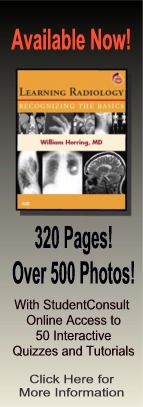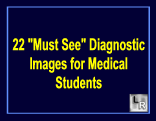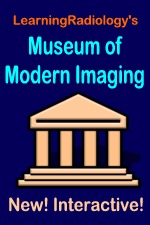| Cardiac | |
|---|---|
| GI | |
| Bone | |
| GU | |
| Neuro | |
| Peds | |
| Faculty | |
| Student | |
| Quizzes | |
| Image DDX | |
| Museum | |
| Mobile | |
| |
Misc |
| Videocasts | |
LearningRadiology Imaging Signs
on Twitter
![]()
Follow us on
What is the most likely diagnosis?
- 41 year-old male, pre-op for hernia surgery
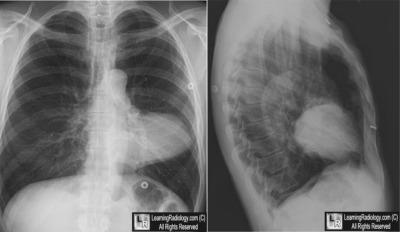
Frontal and Lateral Chest Radiographs
- Tetralogy of Fallot
- Pericardial cyst
- Hypertension
- Congenital defect in pericardium
- Ventricular aneurysm
Additional Images - No additional images
![]()
Additional Images
No additional images
![]()
Answer:
.
4. Congenital Defect in the Pericardium
.
.
More (Click Discussion Tab)
Congenital Defect in the Pericardium
General Considerations
- Rare absence of a part or all of the pericardium
- Due to failure of pericardial development secondary to premature atrophy of the left duct of Cuvier (cardinal vein) which then fails to nourish the left pleuropericardial membrane
- Male:female ratio of 3:1
- May be detected at any age but most commonly in low 20’s
.
This Week
41 year-old male, pre-op for hernia surgery |
Presented as a series of cards, this podcast asks some of the most common causes of neuroimaging findings and diseases making it ideal for a quick review. Can be used as either an audio only or audio/video podcast.; Complements Video Flashcard Podcasts 15, 21,25, 38, 42, 46 and 47. |
Some of the fundamentals of interpreting chest images |
The top diagnostic imaging diagnoses that all medical students should recognize according to the Alliance of Medical Student Educators in Radiology |
Recognizing normal and key abnormal intestinal gas patterns, free air and abdominal calcifications |
Recognizing the parameters that define a good chest x-ray; avoiding common pitfalls |
How to recognize the most common arthritides |
LearningRadiology
Named Magazine's
"25 Most Influential"
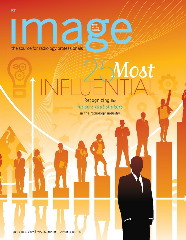
| LearningRadiology.com |
is an award-winning educational website aimed primarily at medical students and radiology residents-in-training, containing lectures, handouts, images, Cases of the Week, archives of cases, quizzes, flashcards of differential diagnoses and “most commons” lists, primarily in the areas of chest, GI, GU cardiac, bone and neuroradiology. |

